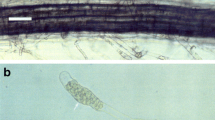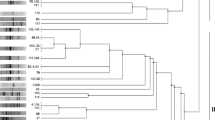Summary
A spontaneous variant, obtained from aFrankia isolate fromAlnus rubra nodules, was compared with the parent strain with regard to infectivity, nitrogenase activity, and electrophoretic and immunological profiles. Both the parent and the variant strain were equally effective in inducing nodulation in seedlings ofA. rubra. All inoculated plants had an active nitrogenase system as measured by the acetylene reduction assay. Electrophoresis of whole cell homogenates on SDS-polyacrylamide slab gels showed similar electrophoretic profiles; however, the variant strain also exhibited striking differences in protein patterns that distinguish it from the parent strain. Immunological analysis of the originalFrankia strain and its variant revealed shared antigens as well as immunologically distinct antigenic determinants in the two strains. The variant strain exhibits a distinct morphology and growth patterns which remain stable after many passages through culture.
Similar content being viewed by others
References
Akkermans A D L and van Dijk C 1976 The formation and nitrogen-fixing activity of the root nodules ofAlnus glutinosa under field conditions.In Symbiotic Nitrogen Fixation in Plants. Ed. P S Nutman, Cambridge, Cambridge University Press pp 511–520.
An C S, Wells J W, Riggsby W S and Mullin B C 1983 Deoxyribonucleic acid base composition of 12Frankia isolates. Can. J. Bot. 61, 2859–2862.
Baker D, Pengelly W L and Torrey J G 1981 Immunochemical analysis of relationships among isolated Frankiae (Actinomycetales). Int. J. Syst. Bacteriol. 31, 148–151.
Baker D and Torrey J G 1979 The isolation and cultivation of actinomycetous root nodule endophytes.In Symbiotic Nitrogen Fixation in the Management of Temperate Forests. Eds. J C Gordon, C T Wheeler and D A Perry. Oregon State University, Corvallis, OR. pp 38–56.
Baker D, Torrey J G and Kidd G H 1979 Isolation by sucrose-density fractionation and cultivationin vitro of actinomycetes from nitrogen-fixing root nodules. Nature 281, 76–78.
Benson D R 1982 Isolation ofFrankia strains from alder actinorhizal root nodules. Appl. Environ. Microbiol. 44, 461–465.
Benson D R, Buccholz S E and Hanna D G 1984 Identification ofFrankia strains by two-dimensional polyacrylamide gel electrophoresis. Appl. Environ. Microbiol. 47, 489–494.
Benson D R and Hanna D 1983Frankia diversity in an alder stand as estimated by sodium dodecyl sulfate-polyacrylamide gel electrophoresis of whole-cell proteins. Can. J. Bot. 61, 2919–2923.
Berg A and Doerksen A 1975 Natural fertilization of a heavily thinned Douglas-fir stand by understory red alder. Res. Note No. 56. Forest Research Laboratory, Oregon State University.
Berry A and Torrey J G 1979 Isolation and characterizationin vivo andin vitro of an actinomycetous endophyte fromAlnus rubra Bong.In Symbiotic Nitrogen Fixation in the Management of Temperate Forests. Eds. J C Gordon, C T Wheeler and D A Perry. Oregon State University, Corvallis, OR. pp 69–83.
Binkley D 1981 Nitrogen fixation and net primary production in a young Sitka alder stand. Can. J. For. Res. 60, 281–284
Binkley D 1982 Nodule biomass and acetylene reduction rates of red alder and Sitka alder on Vancouver Island, B.C. Can. J. For. Res. 11, 281–286.
Burggraaf A J P, Quispel A, Tak T and Valstar J 1981 Methods of isolation and cultivation ofFrankia species from actinorhizas. Plant and Soil 61, 157–168.
Burggraaf A J P and Valstar J 1984 Heterogeneity withinFrankia sp. LDAgpl studied among clones and reisolates. Plant and Soil 78 29–43.
Callaham P, Del Tredici D and Torrey J C 1978 Isolation and cultivationin vitro of the actinomycete causing root nodulation inComptonia Science (Washington, DC) 199, 899–902.
Carpenter C V, Baribo L E, Robertson L R, Van DeBogart F and Onufer G M 1979 Acetylene reduction by excised root nodules fromAlnus rubra andAlnus sinuata.In Symbiotic Nitrogen Fixation in the Management of Temperate Forests. Eds. J C Gordon, C T Wheeler and D A Perry. Oregon State University, Corvallis, OR. pp 475.
Carpenter C V and Robertson L R 1983 Isolation and culture of nitrogen-fixing organisms.In Biological Nitrogen Fixation in Forest Ecosystems: Foundations and Applications. Eds. J C Gordon and C T Wheeler. The Hague, Martinus Nijhoff/Dr. W. Junk Publishers. pp 89–106.
Carpenter C V, Robertson L R, Gordon J C and Perry D A 1984 The effect of four newFrankia isolates on growth and nitrogenase activity in clones ofAlnus rubra andAlnus sinuata. Can. J. For. Res. 14, 701–706.
Crocker R L and Major J 1955 Soil development in relation to vegetation and surface age at Glacier Bay, Alaska. J. Ecol. 43, 427–448.
Davis B D, Dulbecco R, Eisen H N and Ginsberg H S 1980 Microbiology, third ed. Hagerstown, Harper and Row, 7 p.
Dawson J O and Sun S H 1981 The effect ofFrankia isolates fromComptonia peregrina andAlnus crispa on the growth ofAlnus glutinosa, A. cordata, andA. incana clones. Can. J. For. Res. 11, 758–762.
Dillon J T and Baker D 1982 Variations in nitrogenase activity among pure-culturedFrankia strains tested on actinorhizal plants as an indication of symbiotic compatibility. New Phytol. 92, 215–219.
Harrington C A and Deal R L 1982 Sitka alder, a candidate for mixed stands. Can. J. For. Res. 12, 108–111.
Heilman P 1979 Use of alders in coal spoil reclamation in the Pacific Northwest.In Symbiotic Nitrogen Fixation in the Management of Temperate Forests. Eds. J C Gordon, C T Wheeler and D A Perry. Oregon State University, Corvallis, OR. pp 477.
Heilman P 1982 Rates of nitrogen and organic-matter accumulation in coal mine spoils supporting red alder stands. Can. J. For. Res. 12 809–813.
Hoagland D R and Arnon D I 1938 The water culture method of growing plants without soil, circular 347. University of California Agricultural Experiment Station, Berkeley.
Horrière F 1984In vitro physiological approach to classification ofFrankia isolates of ‘the Alnus group’, based on urease, protease and β-glucosidase activities. Plant and Soil 78, 7–13.
Laemmli U K 1970 Cleavage of structural proteins during the assembly of the head of bacteriophage T4. Nature 222, 680–685.
Lechevalier M, Baker D and Horrière F 1983 Physiology, chemistry, serology, and infectivity of twoFrankia isoltates fromAlnus incana subsp.rugosa. Can. J. Bot. 61, 2826–2833.
Lechevalier M and Lechevalier H 1979 Taxonomic position of the actinomycetic endophytes.In Symbiotic Nitrogen Fixation in the Management of Temperate Forests. Eds. J C Gordon, C T Wheeler and D A Perry, Oregon State University, Corvallis, OR. pp 11–123.
Lechevalier M and Ruan J S 1984 Physiology and chemical diversity ofFrankia spp. isolated from nodules ofComptonia peregrina (L.) Coult. andCeanothus americanus L. Plant and Soil 78, 15–22.
McNabb D H and Geist J M 1979 Acetylene reduction assay of symbiotic N2 fixation under field conditions. Ecology 60, 1070–1072.
Mullin B C, Joshi P A and An C S 1983 Isolation and purification of DNA fromAlnus glutinosa nodules. Can. J. Bot. 61, 2855–2858.
Normand P and Lalonde M 1982 Evaluation ofFrankia strains isolated from provenances of twoAlnus species. Can. J. Microbiol. 28, 1133–1142.
Ouchterlony Ö 1958 Diffusion-in-gel methods for immunological analysis.In Progress in Allergy. Ed. P Kallas. Basel: Karger. V. 1–78.
Snedecor G W and Cochran W C 1976 Statistical methods. Sixth edition. Ames, The Iowa State University Press.
Tarrant R F and Miller R E 1963 Accumulation of organic matter and soil nitrogen beneath a plantation of red alder and Douglas-fir. Soil Sci. Soc. Am. Proc. 27, 231–234.
Tisa L, McBrie M and Ensign J C 1983 Studies on growth and morphology ofFrankia strains EAN1pec, EUI1c, CpI1, and ACN1AG. Can. J. Bot. 61, 2768–2773.
Tjepkema J D, Ormerod W and Torrey J G 1980 Vesicle formation and acetylene reduction inFrankia sp. CpI1 cultured in defined nutrient media. Nature 287, 633–635.
Tjepkema J D, Ormerod W and Torrey J G 1981 Factors affecting vesicle formation and acetylene reduction (nitrogenase activity) inFrankia sp. CpI1. Can. J. Microbiol 27, 815–823.
Zhongze Z, Lopez M F and Torrey J G 1984 A comparison of cultural characteristics and infectivity ofFrankia isolates from root nodules ofCasuarina species. Plant and Soil 78, 79–90.
Author information
Authors and Affiliations
Rights and permissions
About this article
Cite this article
Parson, W.L., Robertson, L.R. & Carpenter, C.V. Characterization and infectivity of a spontaneous variant isolated fromFrankia sp. WEY 0131391. Plant Soil 87, 31–42 (1985). https://doi.org/10.1007/BF02277645
Issue Date:
DOI: https://doi.org/10.1007/BF02277645




